JOSE VEROCAY - “Prague’s pathologist”. The history of a Latin-American doctor
Authors:
Ronell Bologna-Molina 1; Gabriela Vigil-Bastitta 1; Vanesa Pereira-Prado 1; Leonel Elola-Verocay 2
Authors‘ workplace:
Molecular Pathology Area, Faculty of Dentistry, Universidad de la República, Montevideo, Uruguay.
1; Faculty of Psychology, Universidad de la República, Montevideo, Uruguay.
2
Published in:
Čes.-slov. Patol., 54, 2018, No. 3, p. 147-150
Category:
History of pathology
Overview
José Verocay (Paysandú 1876 – Eichwald/Dubí, Bohemia 1927) was a Uruguayan anatomopathologist, recognized worldwide as “Prague’s pathologist” (Fig. 1). In 1910, he described, for the first time, the morphological structure later called Verocay’s bodies, which are used for diagnosing schwannoma. He spent the end of the XIXth century and the beginning of XXth century in Charles-Ferdinand University in Prague. During the last years of his life, he tried unsuccessfully to reintegrate himself into the Uruguayan academic community. In 1927, he passed away in Eichwald, Teplitz district, Bohemia.
Keywords:
Prague’s pathologist – Veroca y – Verocay’s bodies
HIS LIFE AND HIS SIGNIFICANCE FOR PATHOLOGY
“...I liked anatomy and I dedicated myself to it. As I understand that men, for being efficient, must dedicate to few things, I dedicated myself completely to the subject I liked. You can’t be everything and I want to be somebody...” (1,2). With these words, Verocay defined his vocation for anatomopathology, a philosophy that would take him far.
José Verocay was a Uruguayan anatomopathologist whose personal and scientific development mainly occurred in Europe at the end of the XIXth century and beginning of the XXth century, in Charles-Ferdinand University in Prague. In 1910, he gained international recognition by describing, for the first time, a morphological structure that later would be called “Verocay’s bodies”, used for diagnosing schwannoma (even though these bodies are not only present in schwannomas).
A typical Verocay’s body consists of a stacked arrangement of two rows of elongated palisading nuclei alternating with acellular zones composed of cytoplasmic processes called Schwann cells (3).
Verocay’s bodies showing horizontal rows of palisading nuclei, separated by acellular zones on a basal membrane, rose colored (3).
Schwannomas, previously known as neurilemmomas and neurinomas of Verocay, are tumors of the peripheral nerve sheath derived from myelinating cells of the peripheral nervous system, which are composed almost entirely of Schwann cells; they usually grow inside a capsule and remain peripheral (3).
“Neuromas” was a denomination taken for the group of tumors of the neural sheath, introduced in 1803 by Louis Odier. This group of tumors were then differentiated thanks to Verocay’s histological observations.
Patients with phakomatosis exhibited tumors that were later called “neuro-fibromas”, name introduced by von Recklinghausen. Verocay called them neurinomas, and Arthur Purdy Stout referred to them as neurilemmomas later on in 1935. Nonetheless, ultrastructural studies in 1968 determine that these tumors are composed mainly of Schwann cells, a discovery achieved by Harkin and Reed, so they call them “schwannomas” (4).
Nowadays, the histological structure of Verocay’s bodies are now generally known as Antoni A/B structures.
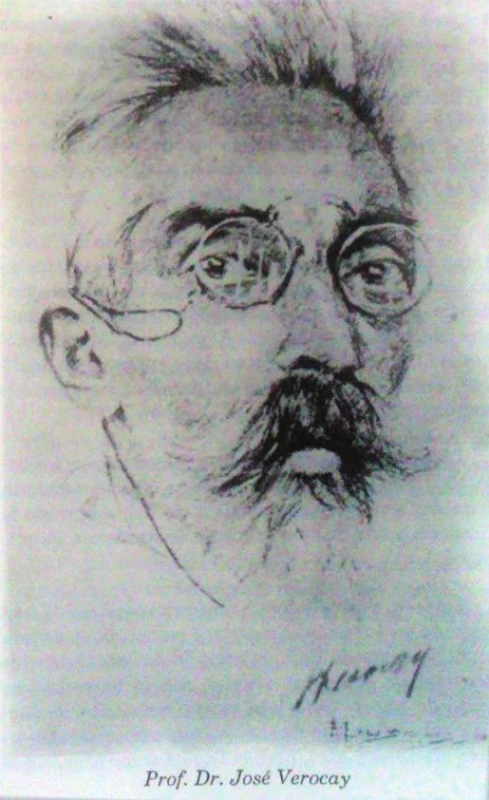
HIS FIRST YEARS AND EDUCATION
José Verocay was born on the 16 June 1876 in Carreras N 908 street, between Sarandí and Ituzangó, Paysandú city, Uruguay, in the house of immigrant parents. His father, Silvino Verocay, was from Tirol (a region that now stretches from south Austria to northeast Italy) and his mother, Rosalía Garrone, was from Piemonte, an north-Italian region. The surname Verocay presumably derives from Verocai, an area next to Cortina d’Ampezzo in northeast Italy, based on a text from that time, Italian: “Nel 1909 fu inaugurata la cappella di Verocai” (1,2).
He first studied under his family’s supervision with a Spanish teacher named Manuel G Alvarez (5). In 1887, at the age of 11, his father took him to Cortina d’Ampezzo, village of Tirol, where thereafter he was taken care of by his uncle Fortunato Verocay, a priest of the church. Fortunato taught him Italian, German and Latin. He continued his studies in Trento, where he studied Ginnasio for eight years, graduating on the 13 July 1897 with the degree of Maturità (analogous to a Bachelor’s degree) (6).
In 1897, Verocay began studying at Medical Faculty (1897-1904) which, at the time, was part of the Austro-Hungarian Empire. It was at one of the oldest and most prestigious universities in Europe, Charles-Ferdinand University in Prague. He regularly took courses with professors such as Huppert, Wölfler and Hans Chiari (2,7).
CAREER AND PUBLICATIONS
He entered the Institute of Pathological Anatomy (Fig. 2), which was directed by professor Hans Chiari (1835-1915) as well as other important figures of pathology such as Richard Kretz (1865-1920) and Anton Ghon (1866-1936). Hans Chiari was the first pathologist in Austria and strongly influenced Verocay’s scientific path (1,2,6).
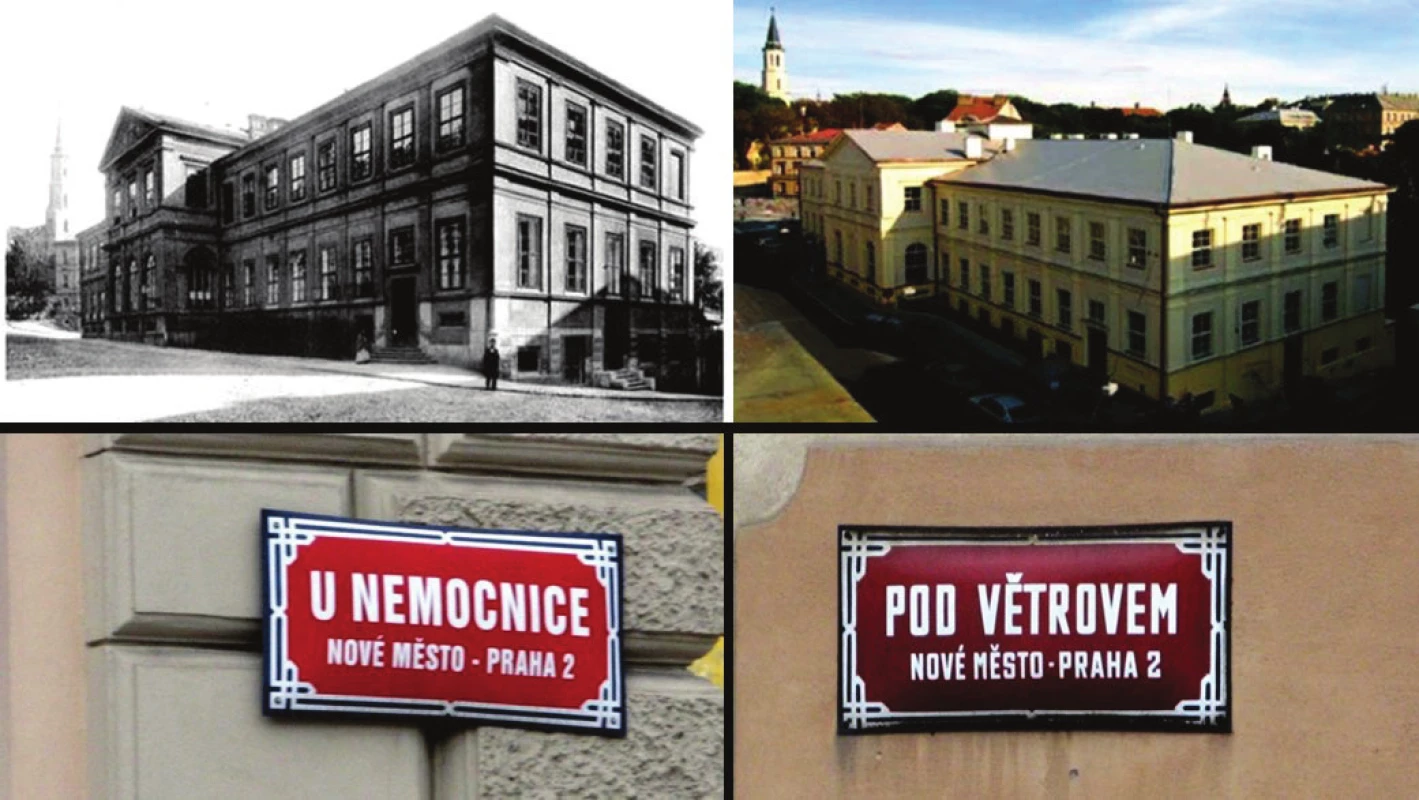
In 1902, he was named the first “Demonstrator“of the Institute. In 1904, he gained the title “Doctor medicinae universae”. Throughout his scientific and teaching career, he obtained the following positions:
- Third Assistent, from the 1 October 1904 to the 31 December 1904.
- Second Assistent and simultaneous substitute of the first Assistent, from the 1 January 1905 to the 30 September 1905.
- -First Assistent, from the 1 October 1905 to the 3 April 1908.
- Honorary teacher, from the 1 May 1908 until he took the position of Privatdozent in 1910 (7).
In the register, the three exam dates (11 July 1901, 10 July 1903 and 13 December 1904) can be seen, as well as his graduation date when he obtained the degree “Doctor medicinae universae” (17 December 1904) (8).
In 1905, at the age of 29, Verocay published his first two drafts. The first one focused on actinomycosis of the pelvic organs of a 14-year-old individual (Aktinomykose der Beckenorgane eines 14 jährigen Mädchens) (9), while the second one analyzed a chicken with multiple hearts (Multiplicitas cordis (heptacardia) bei einem Huhn) (10).
Moreover, he worked with aortic and renal anomalies as well as pseudohermaphroditism. In 1906, he returned to Uruguay for six months, where the dean of the Medical University of Montevideo, Dr. Alfredo Navarro, offered him the recently created role of Director of the Pathological Anatomy Institute. He accepted the offer, traveling back to Prague to plan his eventual return to Uruguay (1,2,7).
He spent from June to October 1906 as an intern at the Sea and Tropical disease Institute in Hamburg, under the direction of Bernhard Nocht. There he met Gustav Giemsa (1867-1947), from whom he learned several bacteriological techniques and perfected his pathological anatomy concepts.
He continued working and published two new papers:
- “Demonstration einer Aortenanomalie” (“Demonstration of aorta anomaly”) (12).
- “Ueber einige Fälle besonderer retroperitonealen Tumoren” (“Some cases of retroperitoneal tumors” ) (13).
Aware of difficulties related to his new position in Montevideo, he continued as first assistant in the Pathological Anatomy Institute of Prague University. Due to the absence of Professor Chiari, he became the deputy Director of the Institute. He received an offer to become a substitute professor in pathological anatomy, but he did not accept it in anticipation of a response from Montevideo University (1).
When he did not receive news regarding his new position in Montevideo, he wrote a letter to Dr. Navarro: “…I remain ignorant of what will happen in Montevideo and if you still are discussing my designation” … “With the dean’s offer I achieved the highest honor as a foreign person, and I believe I can become the first foreigner to whom anyone has made a proposition to be an official lecturer in an Austrian University. Having the title and character of a professor, I should resign to the quality of a Uruguayan subdit becoming an Austrian…and as an orient person I don’t think so” (1,2).
The answer from Montevideo never arrived. Since the position in Uruguay was denied to him, Verocay continued his scientific work in Europe.
In 1907, he published “Ren impar sinister kombiniert mit Anomalien der Genitalorgane, der Baucharterien und des Skelettes” (14). Despite difficulties, plans not coming to fruition and uncertainty, he succeeded in his labor. He wrote a letter to his brother on the 22 January 1908, expressing...“Here I am writing another work on nerves, based on the one I recently wrote (he referred to the one about the origin of certain neural tumors). I am not sure if something is coming from this, but if it does and I prove what I think, it would be something beautiful, and my name will be alive in pathology forever...” (2).
Between 1908-1910 he published four papers. The first three are:
- “Beseitigung der Formolniederschlage aus mikroskopischen Schnitten” (“Removal of formolic precipitates of microscopic cuts”) (15).
- “Multiple Geschwülste als Systemerkrankung am nervösen Apparate” (“Multiple tumors as a systemic disease in the nervous system”) (16).
- “Ueber ein neues Verfahren zur Färbung des Bindegewebes” (“About a new procedure for staining connective tissue”) (17).
Around this time, he received a job offer as director of pathological anatomy at the Medical School of Boston University, under the direction of the a globally recognized pathologist named William Thomas Councilman (1854-1933). However, he did not accept the offer (7).
In 1910, he published the article for which he later became known internationally, titled “Zur Kenntnis der Neurofibrome” (“About the knowledge of neurofibromes”) (Fig.3) (18).
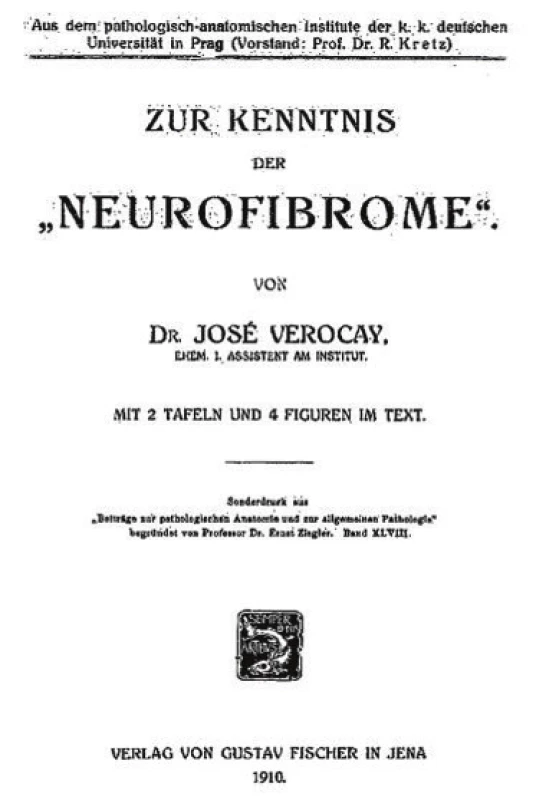
In this work he described the histogenesis of neurinomes, beginning with Schwann cells, and used one affecting the acoustic nerve as a model. He analyzed its polymorphism microscopically and described structures that today carry his name “Verocay’s bodies” (6).
His discoveries were immediately accepted by globally renowned experts such as Pío del Río Hortega (1882-1945), Kart Albert, Ludwig Aschoff (1866-1942), and Harvey W. Cushing (1869-1939), the latter of which declared in 1917: “One of the most complete studies about this tissue is the one of Verocay, proposing the name of neurinome to call this singular tumors of the nerves. In all, the observations of Verocay about a case of generalized neurofibromatosis and four cases of isolated acoustic tumors are of great importance and are novel in the medical field” (7).
In this same year, on the 15 December, the Professors College of Prague decided to name Verocay as an Privatdozent, of the Pathological Anatomy Institute of German University of Prague. As a foreigner, the Professors College made an exception to their normal policy in naming him to this position. He represented the previous position of deputy Director of the subject.
In 1914, he received an offer to become a professor of pathological anatomy, but he rejected it because he would have to give up his Uruguayan citizenship (11). Verocay wanted to return to Uruguay to advance pathological studies there. He sent 200 histological samples to Montevideo at one time, the product of his labor on autopsies, with the descriptions and clinical pathological indications attached (20).
In 1911, he published “Ein Fall von maligner Hypophysenganggeschwulst” (“A malignant case in pituitary tract”) (21).
In 1913, he took a position in Vienna as a “Prosector” of the Hospital “Kaiserin Elisabeth,” substituting for Professor Schlagenhaufer (2).
He published only one article in Italian: “Contributo alla casistica dell´atresia congenita dell´aorta in prossimità del dutto arterioso del Botallo” (“Contribution to the casuistry of the congenital aortic atresia next to the Botallo’s arterial duct”) (22) and Pseudohermaphroditismus masculinus completus” (”Complete male pseudohermaphroditism”) (23).
Verocay’s plans to return to Uruguay were delayed by the beginning of World War One. He was called to Vienna. As a foreigner he could avoid getting involved in the conflict, but for humanity reasons he entered the military health division of the Austrian army, working at the hospital of infectious diseases as “Prosector” (6).It was a hospital that contained 2400 beds for injured people coming from every war zone of the empire. Verocay, as a dissector and bacteriologist, conducted a large number of autopsies. He researched anatomic lesions of the lungs caused by infectious agents. His samples allowed him to initiate histopathology studies of the flu, which began its epidemic and pandemic propagation at the end of the war.
In 1918, the war ended and he was honored with a plaque as a Red Cross Official (2).
He also continued publishing papers (1915-1916):
- “Arterienverkalkung bei angeborener Lues” (“Arterial calcifications”) (24).
- “Hat Unwegsamkeit des Ductus deferens Atrophie des Hodens zur Folge?” (“Impassability of the deferens duct (= vas deferens) causes atrophy of the testis?”) (25).
- “Ein junges menschliches Ei ” (“A young egg of man”) (26).
LAST YEARS
The dismemberment of the Austro-Hungarian monarchy, with the consequent devaluation of its currency, led him to lose his already small savings in crowns, making it difficult for him to remain in Prague. In 1919, he therefore renounced his position as “Prosector” and returned to Uruguay (6).
He relocated to his family cottage in Paso de los Mellizos, Río Negro. There, he worked in the family business as a general doctor. In 1920, at the age of 44, he married Carlotta Rühr, whom he met in Vienna, and would have four children, relocating to Montevideo (1,2).
In 1921, he entered the military hospital as a doctor in Montevideo (1).
In 1924, he gave lectures on pathological anatomy in the dental school of Montevideo at a request of the director Dr. Sartori (27). That year, he aspired to the position of Anatomical Pathology professor in the Faculty of Medicine. This position was denied unfairly to him in a letter that many students and doctors criticized and were upset by (2).
Finally, on 18 March 1925 he became the chief of the laboratory of Anatomical Pathology in the School of Dentistry.
In 1927, he was hired by Professor Ricaldoni, director of the pathological anatomy laboratory of the Neurological Institute, but only remained in that position for 64 days due to lung and heart diseases that afflicted him. He decided to travel to Vienna for a medical appointment with his cardiologist friends (2).On the 24 August, two days before he travelled to Europe, dental and medical students put on a public ceremony in his honor, in the great salon of the medical university. The students proclaimed him as “recognized professor of the actual medical generation” (28), and as “professor by right of the medical youth” (29).Verocay would go on to say: “I am sorry to leave Uruguay without doing what I proposed to do; I couldn’t offer to my country, as far as I wanted, my knowledge and my spiritual energy”, adding “destiny doesn’t want me to come back to my homeland; I would die there” (2).
Two days after the 26 August, he traveled to Europe with the hope of finding a better climate for his health issues. But when he arrived in Hamburg, his health worsened. On Christmas eve of 1927 he passed away in Eichwald, Teplitz, Bohemia, at 51 years old (2-6).In 1928, at the initiative of the Administration National Council, his corpse was returned to Uruguay and buried on the 10 April 1930 in the Pantheon of the Servants of the Homeland in the Cemetery of the Buceo in Montevideo (Fig. 4) (2).
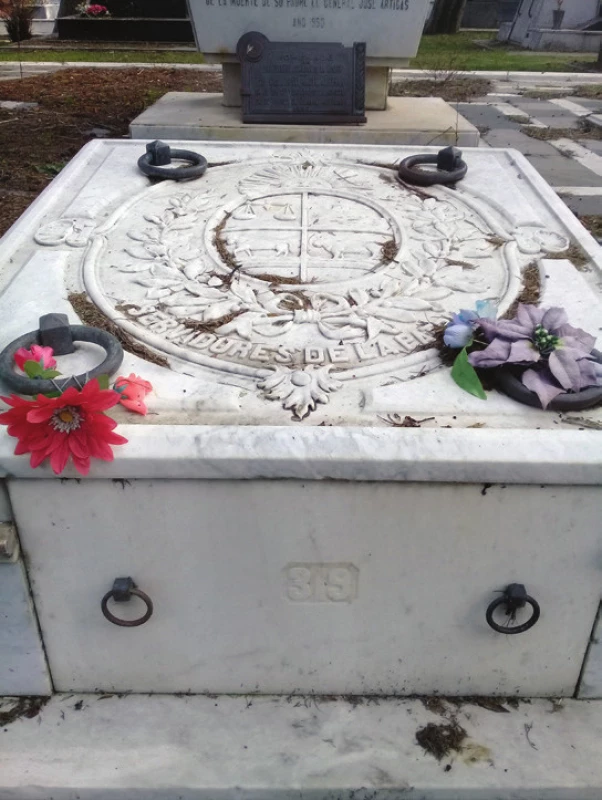
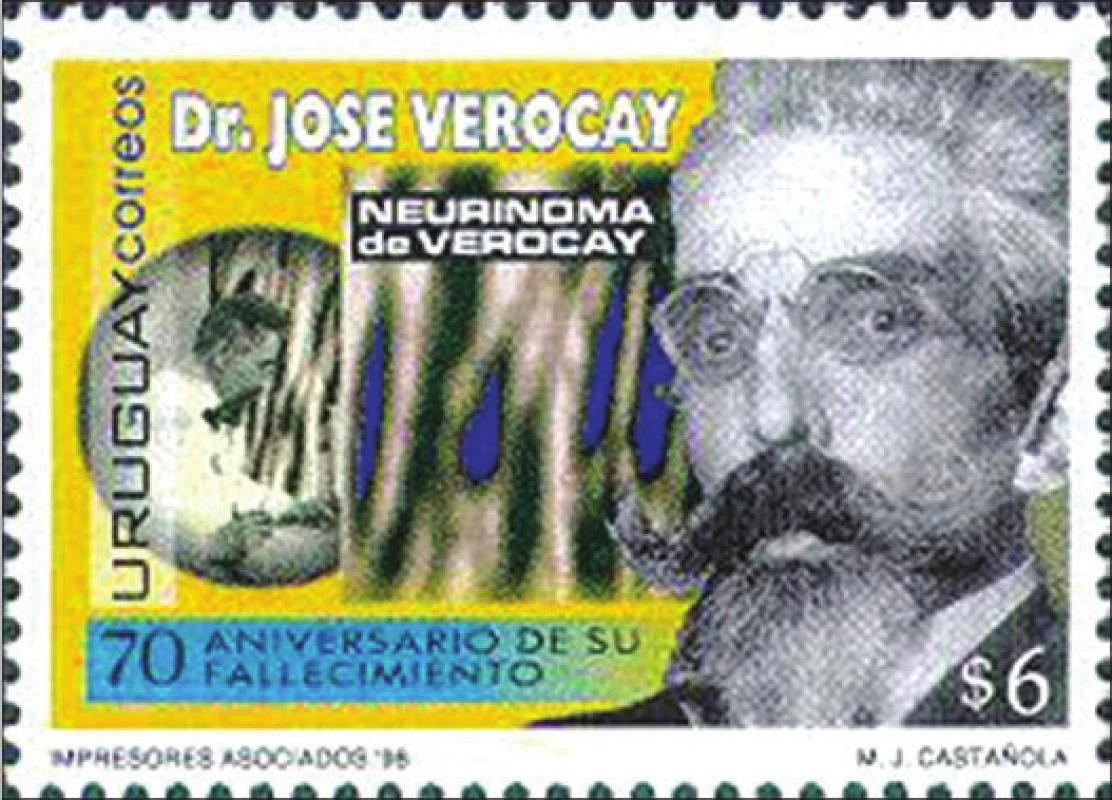
Uruguayan Mail, celebrating the 70th anniversary of death, issues a stamp, within the series “illustrious doctors” in the name of Dr. Jose Verocay (Fig. 5).
CONFLICT OF INTEREST
The authors declare that there is no conflict of interest regarding the publication of this paper.
Correspondence address:
Vanesa Pereira-Prado
Gral Las Heras 1925, 11600 Montevideo,
tel.: +598 95 896 043,
e-mail: vanesapereira91@hotmail.com
Sources
1. Speroni Vener J. Vida y obra de José Verocay. Universidad de la República. Div. Publicaciones y Ediciones, 1978. Montevideo, Uruguay.
2. Speroni J. José Verocay. Médicos Uruguayos Ejemplares. Biográficas Historia del Hospital Maciel de Horacio Gutierrez Blanco, Tomo II 60 semblanzas, 1989; 183-185. Montevideo, Uruguay.
3. Joshi R. Learning from eponyms: José Verocay and Verocay bodies, Antoni A and B, Nils Antoni and schwannomas areas. Indian J Dermatol 2012; 3(3): 215-219.
4. Čech P. José Juan Verocay, “el patólogo de Praga”. Cesk Patol 2012; 48(2): 107–111.
5. Laurino J. Un médico sanducero que nos hizo conocer en toda Europa. Diario “El Día”1970. Montevideo, Uruguay.
6. Ortiz-Hidalgo C. José Verocay. Neurinomas y cuerpos de Verocay y otras contribuciones a la medicina. Rev Neurol 2004; 39(5): 487-491.
7. De Armas R, Otero M, Čech P. José Verocay (1876–1927). Pod Vetrovem ”Debajo de un lugar expuesto al viento“. Montevideo.
8. Archiv Univerzity Karlovy, NLF, hlavní protokoly rigoros 1885 – 1911.
9. Verocay J. Ueber einige Fälle besonderer retroperitonealen Tumoren. Z Heilkd 1906; 27 : 176–192.
10. Verocay J. Ren impar sinister kombiniert mit Anomalien der Genitalorgane, der Baucharterien und des Skelettes. Prag Med Wochenschr 1907; 32 : 637–641.
11. Siller WG. Aortic dextroposition complexes in the fowl: a study in comparative pathology. J Pathol Bacteriol 1967; 94 : 155–170.
12. Verocay J. Demonstration einer Aortenanomalie. Prag Med Wochenschr 1906; 31 : 408–409. 21.
13. Verocay J. Ueber einige Fälle besonderer retroperitonealen Tumoren. Z Heilkd (Wien – Leipzig) 1906; 27 : 176–192.
14. Verocay J. Ren impar sinister kombiniert mit Anomalien der Genitalorgane, der Baucharterien und des Skelettes. Prag Med Wochenschr 1907; 32 : 637–641.
15. Verocay J. Beseitigung der »Formolniederschläge« aus mikroskopischen Schnitten. Zentralbl Allg Pathol Pathol Anat (Jena) 1908; 19 : 769–774.
16. Verocay J. Multiple Geschwülste als Systemerkrankung am nervösen Apparate. In: Dittrich P. (ed). Braumüller; 1908 : 378–415.
17. Verocay J. Ueber ein neues Verfahren zur Färbung des Bindegewebes. Verh Ges Dtsch Naturf Ärzte 1908; II(2): 52–55.
18. Verocay J. Zur Kenntnis der »Neurofibrome«. Zieglers Beitr Pathol Anat Allg Pathol 1910; 48 : 1–69.
19. Verocay J. Zur Kenntnis der »Neurofibrome«. Jena: Gustav Fischer 1910.
20. La protesta del Doctor Verocay. Sobre la actitud del Decano de la Facultad. El Estudiante Libre. 1926; VII (60): 9-11.
21. Ein Fall von maligner Hypophysenganggeschwulst. Prag Med Wschr 1911; 36 : 656.
22. Contributo alla casistica dell’atresia congenita dell’aorta in prossimità del dutto arterioso del Botallo. Patológica 1913; (101): 1-12.
23. Pseudohermaphroditismus masculinus completus. Verh Deutsch Naturforscher und Aerzte, Wien. 1913; 13 : 25-46.
24. Arterienverkalkung bei angeborener Lues. Frankf. Zschr. 1915
2 5. Hat Unwegsamkeit des Ductus deferens Atrophie des Hodens zur Folge? Prag Med Wschr 1915; 40(11):1-7.
26. Ein junges menschliches Ei. Archiv Gynaeko Berlin 1916; 105 : 151-68.
27. Sartori S. Memoria de La Escuela de Odontología correspondiente al periodo de 1922-1925. Suplemento de los anales de la Universidad Montevideo N 4.
28. El homenaje al Doctor Verocay la asociación lo encaró como un agravio al ilustre profesor. Estudiante libre, 1927; VIII(76): 9.
29. El profesor Verocay. El Estudiante libre, 1930; XI(103): 21.
Labels
Anatomical pathology Forensic medical examiner ToxicologyArticle was published in
Czecho-Slovak Pathology
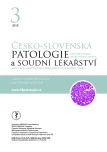
2018 Issue 3
Most read in this issue
- Intraoperative consultation in gynecologic pathology
- Aberrant axillary breast tissue with pseudoangiomatous stromal hyperplasia in a man
- Molecular methods for detection of prognostic and predictive markers in diagnosis of adenoid cystic carcinoma of the salivary gland origin
- Clinicopathological analysis of programmed death-ligand 1 testing in tumor cells of 325 patients with non-small cell lung cancer: Its predictive and potential prognostic value
